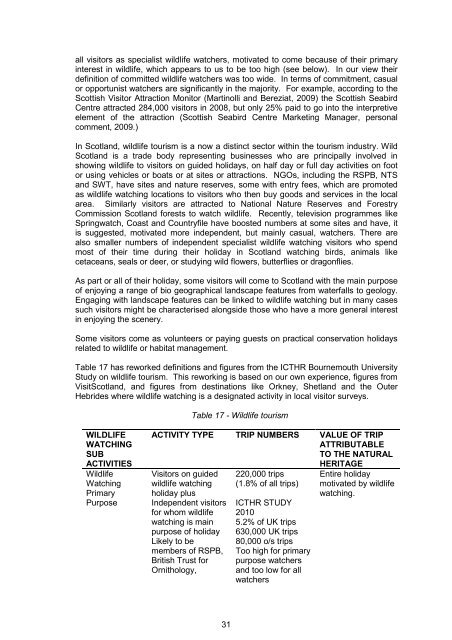Assessing the economic impacts of nature based tourism in Scotland
Assessing the economic impacts of nature based tourism in Scotland
Assessing the economic impacts of nature based tourism in Scotland
Create successful ePaper yourself
Turn your PDF publications into a flip-book with our unique Google optimized e-Paper software.
all visitors as specialist wildlife watchers, motivated to come because <strong>of</strong> <strong>the</strong>ir primary<br />
<strong>in</strong>terest <strong>in</strong> wildlife, which appears to us to be too high (see below). In our view <strong>the</strong>ir<br />
def<strong>in</strong>ition <strong>of</strong> committed wildlife watchers was too wide. In terms <strong>of</strong> commitment, casual<br />
or opportunist watchers are significantly <strong>in</strong> <strong>the</strong> majority. For example, accord<strong>in</strong>g to <strong>the</strong><br />
Scottish Visitor Attraction Monitor (Mart<strong>in</strong>olli and Bereziat, 2009) <strong>the</strong> Scottish Seabird<br />
Centre attracted 284,000 visitors <strong>in</strong> 2008, but only 25% paid to go <strong>in</strong>to <strong>the</strong> <strong>in</strong>terpretive<br />
element <strong>of</strong> <strong>the</strong> attraction (Scottish Seabird Centre Market<strong>in</strong>g Manager, personal<br />
comment, 2009.)<br />
In <strong>Scotland</strong>, wildlife <strong>tourism</strong> is a now a dist<strong>in</strong>ct sector with<strong>in</strong> <strong>the</strong> <strong>tourism</strong> <strong>in</strong>dustry. Wild<br />
<strong>Scotland</strong> is a trade body represent<strong>in</strong>g bus<strong>in</strong>esses who are pr<strong>in</strong>cipally <strong>in</strong>volved <strong>in</strong><br />
show<strong>in</strong>g wildlife to visitors on guided holidays, on half day or full day activities on foot<br />
or us<strong>in</strong>g vehicles or boats or at sites or attractions. NGOs, <strong>in</strong>clud<strong>in</strong>g <strong>the</strong> RSPB, NTS<br />
and SWT, have sites and <strong>nature</strong> reserves, some with entry fees, which are promoted<br />
as wildlife watch<strong>in</strong>g locations to visitors who <strong>the</strong>n buy goods and services <strong>in</strong> <strong>the</strong> local<br />
area. Similarly visitors are attracted to National Nature Reserves and Forestry<br />
Commission <strong>Scotland</strong> forests to watch wildlife. Recently, television programmes like<br />
Spr<strong>in</strong>gwatch, Coast and Countryfile have boosted numbers at some sites and have, it<br />
is suggested, motivated more <strong>in</strong>dependent, but ma<strong>in</strong>ly casual, watchers. There are<br />
also smaller numbers <strong>of</strong> <strong>in</strong>dependent specialist wildlife watch<strong>in</strong>g visitors who spend<br />
most <strong>of</strong> <strong>the</strong>ir time dur<strong>in</strong>g <strong>the</strong>ir holiday <strong>in</strong> <strong>Scotland</strong> watch<strong>in</strong>g birds, animals like<br />
cetaceans, seals or deer, or study<strong>in</strong>g wild flowers, butterflies or dragonflies.<br />
As part or all <strong>of</strong> <strong>the</strong>ir holiday, some visitors will come to <strong>Scotland</strong> with <strong>the</strong> ma<strong>in</strong> purpose<br />
<strong>of</strong> enjoy<strong>in</strong>g a range <strong>of</strong> bio geographical landscape features from waterfalls to geology.<br />
Engag<strong>in</strong>g with landscape features can be l<strong>in</strong>ked to wildlife watch<strong>in</strong>g but <strong>in</strong> many cases<br />
such visitors might be characterised alongside those who have a more general <strong>in</strong>terest<br />
<strong>in</strong> enjoy<strong>in</strong>g <strong>the</strong> scenery.<br />
Some visitors come as volunteers or pay<strong>in</strong>g guests on practical conservation holidays<br />
related to wildlife or habitat management.<br />
Table 17 has reworked def<strong>in</strong>itions and figures from <strong>the</strong> ICTHR Bournemouth University<br />
Study on wildlife <strong>tourism</strong>. This rework<strong>in</strong>g is <strong>based</strong> on our own experience, figures from<br />
Visit<strong>Scotland</strong>, and figures from dest<strong>in</strong>ations like Orkney, Shetland and <strong>the</strong> Outer<br />
Hebrides where wildlife watch<strong>in</strong>g is a designated activity <strong>in</strong> local visitor surveys.<br />
Table 17 - Wildlife <strong>tourism</strong><br />
WILDLIFE<br />
WATCHING<br />
SUB<br />
ACTIVITIES<br />
Wildlife<br />
Watch<strong>in</strong>g<br />
Primary<br />
Purpose<br />
ACTIVITY TYPE TRIP NUMBERS VALUE OF TRIP<br />
ATTRIBUTABLE<br />
TO THE NATURAL<br />
HERITAGE<br />
Visitors on guided<br />
wildlife watch<strong>in</strong>g<br />
holiday plus<br />
Independent visitors<br />
for whom wildlife<br />
watch<strong>in</strong>g is ma<strong>in</strong><br />
purpose <strong>of</strong> holiday<br />
Likely to be<br />
members <strong>of</strong> RSPB,<br />
British Trust for<br />
Ornithology,<br />
220,000 trips<br />
(1.8% <strong>of</strong> all trips)<br />
ICTHR STUDY<br />
2010<br />
5.2% <strong>of</strong> UK trips<br />
630,000 UK trips<br />
80,000 o/s trips<br />
Too high for primary<br />
purpose watchers<br />
and too low for all<br />
watchers<br />
Entire holiday<br />
motivated by wildlife<br />
watch<strong>in</strong>g.<br />
31

















